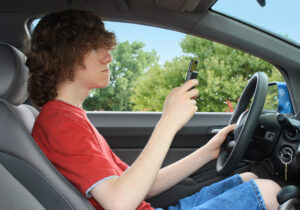 As parents, we all know that using a cellphone while driving can lead to violent collisions that cause serious injury and death and teen drivers are particularly vulnerable to the temptation of using a cell phone behind the wheel. Unfortunately, many parents have not set a good example for our children when it comes to cellphone use while driving. In this blog, we encourage all drivers (not just parents) to turn off and put away the cell phone while driving.
As parents, we all know that using a cellphone while driving can lead to violent collisions that cause serious injury and death and teen drivers are particularly vulnerable to the temptation of using a cell phone behind the wheel. Unfortunately, many parents have not set a good example for our children when it comes to cellphone use while driving. In this blog, we encourage all drivers (not just parents) to turn off and put away the cell phone while driving.
Three Majors Dangers of Cellphones
Distracted driving in any manner is dangerous, but we live in a time where distracted driving has become an epidemic for one reason: the cellphone. Here are three reasons why the cellphone poses unique dangers to drivers.
- People Feel the Need to Stay Connected: All of us feel a strong need to stay connected. Once you give people technology that helps them stay connected, it isn’t easy to take it away. The problem is that cellphone use is just not limited to “staying connected” by talking and texting. Being connected means many things, including the pressure many drivers now feel to follow and update social media.
- People Feel the Need to Multi-task Behind the Wheel: The new smartphones are like desktop computers, even better. Through a smartphone, you can not only stay connected, but browse the internet, shop, play music and videos, and a host of other functions that are not essential to driving. In fact, new surveys show that many of us, including teen drivers, use multiple cellphone functions during one trip in the car.
- People Feel the Need to Urgently Respond: When an incoming message comes through on your cellphone, you might feel the need to reply immediately. The alerts like beeps or rings send people directly to their phones, instead of waiting until they are safely parked or at their destination.
Glove Box (or Put Away) the Phone
The most effective way to prevent the use of cellphones—and the dangers associated with using cellphones—while driving is to avoid the temptation altogether and put the phone away. For years, driver safety experts have been trying to deal with cellphone use while driving. Many experts are now saying that it is a matter of personal responsibility because people want to govern themselves. So we are recommending everybody exercise personal responsibility in light of the dangers listed above.
When I drive, I know that if I don’t put the phone away, I will likely fall prey to the cellphone dangers just like everybody else. But I am a driver safety advocate who also spends seven days a week representing people badly injured or killed in car accidents. From my life’s work, I know and appreciate the dangers of the cellphone. But what about you? You may not appreciate the dangers that I do because you don’t confront them every day.

So, as it relates to protecting teen drivers, how is a parent best able to convince their teen driver to stash the phone away to protect them?
First and foremost, we as parents need to set the example by glove boxing the phone when we drive. Our children are always watching us. If we want our children to take a specific action, there are no shortcuts; we need to be exercising the behaviors we espouse.
Second, we need to talk to our children about driving privileges. Like most privileges, there are responsibilities. Privilege without responsibility won’t last long. Our children need to learn that lesson. Drivers have a high responsibility, which is to exercise the highest degree of care in the operation of a motor vehicle. You can explain that this responsibility is in place to protect themselves and protect their passengers and every other driver or pedestrian on the road from life-changing severe injury or death.
Third, after you have established a driver’s responsibilities and the life and death reasons why the cellphone needs to be put away, you must instruct the young driver to create a routine and habit. The seat belt works this way. Research shows that habits can begin after 21 days.
This is so important to begin when you are instructing a child to drive. In Missouri, parents have the responsibility to supervise the driving during the period of permit driving. After a teen receives the immediate license, a parent should continue to supervise driving. This provides an excellent opportunity to reinforce the habit of glove boxing the phone.
More Thoughts for Parents
We have already discussed the need for a parent to be a good example by glove boxing the phone. But here is something else I would like parents to think about.
To avoid the need to use the phone while en route, before starting the car, get everything you want or need to do on your phone done. Do you want to put on a podcast or playlist? Do that before you put the car in gear and put your phone away after you are done. Do you need to start the navigation? Again, do it before you leave. Then, put your phone on silent and away.
Should the need to make a call arise while driving, you need to do more than just pull over on the side of the road, which can be just as dangerous as trying to use your phone while driving. If the need to use your phone arises, get off on the next exit or nearest public building. Proceed to a designated parking spot in a parking lot, park, and then pull out your phone.
Stopping on the shoulder should be reserved only for car troubles or emergencies. The shoulder or side of the street is NOT a safe place to place a call or send a text.
What About Hands-Free Options?
While hands-free operation helps minimize some of the dangers associated with using a phone while driving, it doesn’t eliminate them entirely. For example, talking on the phone while hands-free does free up your hands, but what about your mind? Are you fully focused on the road if you are engaging in conversation?
More than likely, you aren’t going to be aware of upcoming threats because you aren’t entirely focused on the task of driving. This is called cognitive inattention. Multitasking in this way doesn’t necessarily take your eyes off the road, but it takes your mind off the road, which limits your ability to react to stopping traffic, roadway obstacles, and reckless drivers.
Learn more about teen driver safety with the other blogs in this series.
Drive By Example: Show Your Teens How to Drive Safely






